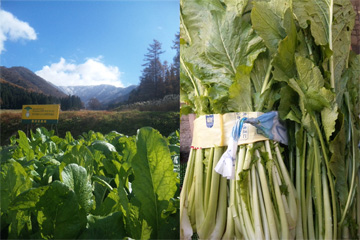Enjoying Tasty and Healthy Foods
“Ishoku-dogen” is an idea of preventing and curing disease by eating healthily on a daily basis. In order to do this, it is important to have a balanced diet. To have a balanced diet, it is necessary to prepare a variety of ingredients and know appropriate cooking methods. Soils and water have to be healthy and rich to provide a variety of good-quality food. The interrelationship between diets, health and biodiversity is obvious.
How should we think about biodiversity in order to enjoy “eating” and stay “healthy”?
Ms. Nozomi Tanabe, Broadcaster, Weather Forecaster and Vegetable Sommelier, answered our questions.
- Questions answered by: Nozomi Tanabe
- Broadcaster, Weather Forecaster and Vegetable Sommelier

Q1
Why is it healthy to eat “seasonal” and a variety of foods?
A
Foods in season are rich in nutrients and umami. Seasonal vegetables make our bodies adaptable to natural rhythms that change seasonally. For example, wild vegetables which have a bitter taste such as fukinoto (butterbur bulb-like shoots) that are available in spring. As older Japanese people say, “add something bitter to spring dishes,” bitterness of wild vegetables awakens our bodies that became rusty during winter. In the heat of summer, sun-ripened tomatoes and bell peppers rich in vitamins are in season. Also, juicy gourds such as cucumbers and water melons help turn down body heat. In autumn, harvesting of root crops increases. We can prepare for winter by eating root crops such as sweet potatoes that warm our bodies. In winter, Chinese cabbage and garland chrysanthemum necessary for nabemono (hot pot winter cuisine) become more delicious and provide us vitamins in winter. The term “Shindofuji” indicates that human bodies and their environment are connected. Eating “foods in season” appropriate to the local climate where you live leads making us seasonally adaptable.

Q2
It is said that vegetables typical of local climates are called “traditional vegetables.” What are traditional vegetables?
A
Traditional vegetables are adapted to local climates. In the Edo Period, a priest in Nozawa Onsen (hot spring) Village, Nagano Prefecture, brought back Ten-noji radish, a traditional vegetable of Osaka Prefecture. But when he raised the radish, only leaves and stems grew large: it is said that this is the birth of a traditional vegetable of Nagano, “Nozawana.” Osaka’s radish tried to survive in Nagano’s severe winter and snowy climate by making its leaves and stems large. This is the vigor of traditional vegetables. There are a variety of radishes such as Nerima daikon radish that Tokugawa Tsunayoshi (the 5th shogun of the Tokugawa dynasty) ordered cultivated, or Miura daikon radish that grows in the mild climate of Miura Peninsula of Kanagawa Prefecture. These are both daikon radish – but the taste and shape are very different.
Traditional Vegetables are responsive to natural rhythms. Therefore, regions and seasons are limited. Since climate adaptable traditional vegetables are less dependent on agricultural chemicals, soils are also preserved. In the soils a variety of living things thrive and the biodiversity is accordingly conserved.
Left: Nozawana field (Photo: Nozomi Tanabe)
Right: Nozawana (Photo: Nozomi Tanabe)

Q3
How can we conserve biodiversity by eating healthy and tasty foods?
A
Kanji characters used for shizen (Japanese word representing nature) mean “as it is.” Nature is self-reliant and artificial power is not added. Humans eat living things in nature in order to live. It is important for us to realize that we are allowed to live as part of nature. Vegetables that survive in severe climates are not only tasty but also remind us of powerful energy of the land. For example, the taste of tap water and spring water are very different. Spring water is dainty and delicious due to a variety of natural elements including purification by microbes. When walking through a beech forest, we can feel a soft layer under foot as the forest is covered by leaf mulch rich in nutrients. Mulch soils are produced by decomposition mediated by tiny bugs and microbes. Rain and snow slowly penetrate into the soils and the water is thereby purified. The soils store nutrients, including minerals, and tasty groundwater is made. We can live by using the natural blessings from various living things. As part of nature, we should taste the blessings without disturbing natural rhythms. Hopefully, we would like to maintain the health of both humans and the earth.
There are four seasons in the Japanese Archipelago stretching from north to south, and the food culture appropriate to natural rhythms in each season is maintained locally. Local cuisine is filled with knowledge and nutrients that enable us to live healthily in local climates. Local vegetables in season also tell us of the arrival of the next seasons. Tasting vegetables in season also means nurturing rich minds that can feel natural lives. The appreciation of a variety of local, seasonal foods leads to biodiversity conservation.
Thank you very much, Ms. Tanabe










